DVD Backup Using DVD2OneOriginal Page URL: https://www.digital-digest.com/articles/dvd2one_backup_page1.htmlAuthor/Publisher: jmet Date Added: Feb 10, 2006 Date Updated: Feb 10, 2006  Software you will need: DVD2One With DVD2One you can make movie-only and full disk copies for personal use on a single DVD-Recordable. Key features include: Note: DVD2One software only works with unprotected DVD files. DVD2One has no "decrypting" abilities. Settings: There are 7 sections you have settings for: Lets start by customizing the settings, click "File" (blue), then "Preferences" (red). (Screen Shot Below) 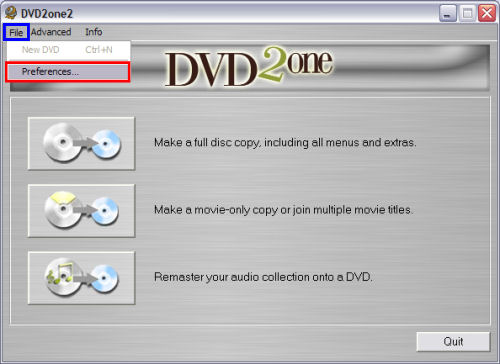 Now on this screen, there is a drop down box at the top to select the settings for each 7 sections I listed above. The first section you will get to is the "User Interface" section (red). Basically all there is to do here is select the language you want DVD2One to use (blue). English, Japanese, Dutch, French, German, Italian, Portuguese and Spanish are the supported languages. (Screen Shot Below) 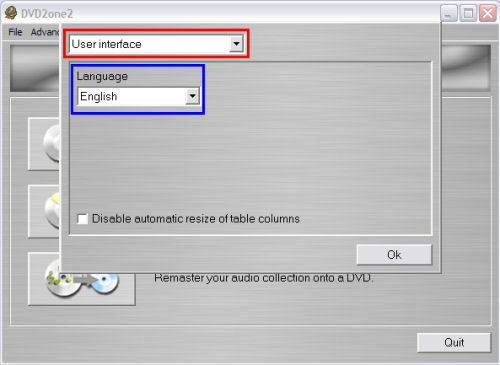
Now lets set the burning section. There is a lot of stuff to cover here. Its all really simple though.
The first thing is "Output type" (yellow). That is what type of file(s) do you want DVD2One to output. If you select "File set", DVD2One will generate a set of DVD compliant files such as .BUP, .IFO, and .VOB files (red). DVD2One also accepts these types of files as a Input type. Acceptable output is your intend on burning with Nero in DVD-Video mode. If you select "Image", DVD2One will generate a single, ready to burn DVD .ISO file (blue). Perfect if your burning with DVD Decrypter or ImgBurn. If you select "Burn", DVD2One will generate an .ISO file as mentioned above and it will burn it automatically to a blank DVD after encoding (green). If you select "Ask before processing", DVD2One will bring up this screen as you click the process button. You can then select what kind of output you want (purple). (Screen Shot Below) 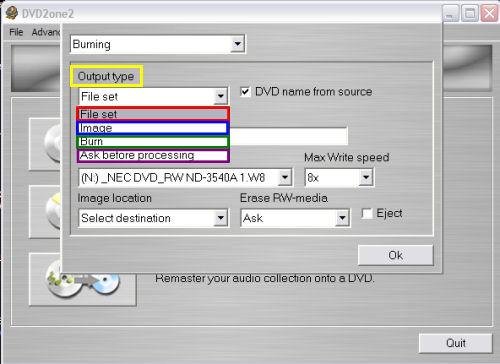 Next is "DVD name" (red). Here is where you set the name of the DVD. This is the name that is given to the output. When the output is a fileset, it will be the name of the directory in which the fileset is stored. When the output is an image, it will be the name of the image file itself as well as the volume name of the dvd when the image is burned on a blank DVD. This is also what you see before your drive letters name in the My Computer screen or Windows Explorer. (Screen Shot Below) 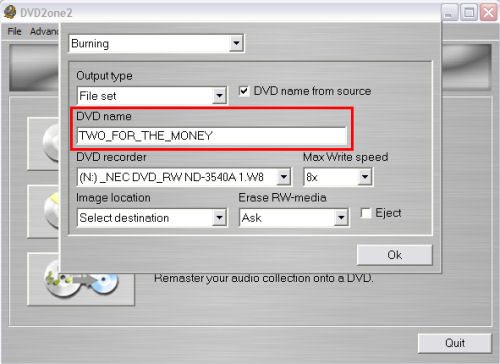
Next thing is "DVD recorder" & "Max Write speed".
"DVD recorder" box is where you would select which drive you want DVD2One to use when burning for you (red). in case you have more than 1 recorder. "Max Write speed" box is where you can also tell DVD2One the max speed to be used when burning (blue). Warning: Burning to fast on low quality media could result in undesirable playback. I recommend burning at 4X for the best results. (Screen Shot Below) 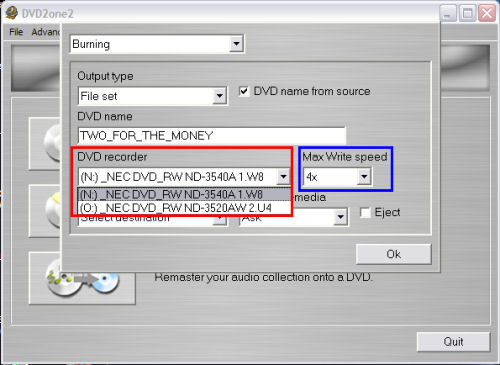 Next thing is "Image location". The "Image location" option is only used when the output type is set to burn. If you select "Use temporary" (red), DVD2One will put the image file in a temporary folder and will delete it after burning is completed. Do not use this option if you need to burn more than 1 copy. If you select "Select destination" (blue), DVD2One will ask you where you want to save the image file, just like it will do when the output type is set to image. After burning, the image file is not deleted, so that you can burn it again. (Screen Shot Below) 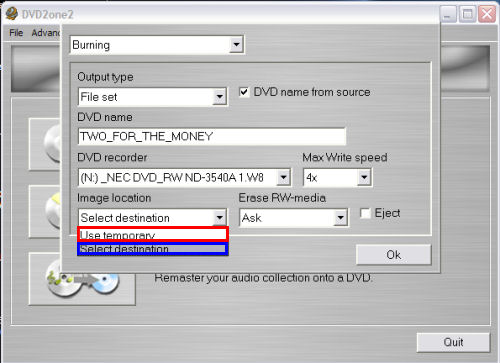
Next is "Erase RW-media".
When you insert a rewritable (RW) disc, DVD2One will detect whether the disc is empty or already has data on it. If you select "Erase always" (red), DVD2One will erase the disc without asking, even when it already contains data. If you select "Ask" (blue), DVD2One will ask if the data on this disk may be overwritten. (Screen Shot Below) 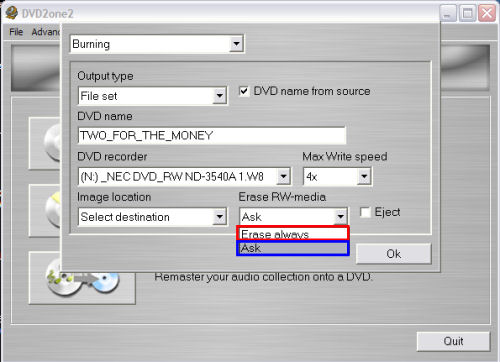
Now on the the "Default Audio selection" (red).
Here is where you tell DVD2One what kind and language audio streams you want. Pick your language (English for me) (blue), then pick what type of audio streams (green) you want DVD2One to include on your backup or all of them if you wish. After you click what type you want, then click the > button (purple) to add this combo to the list. You can also remove entries with the x button (yellow). Double clicking on a row will force the selected audio track to be played when you start the movie (black). This forced audio track is marked with a * behind the language (black). Any type All types will be selected. AC3 multichannel This will only select AC3 5.1 audio tracks. This type is usually the main audio track and backward compatible with stereo playback. This is the recommended type. AC3 stereo This will only select 2 channel AC3 tracks. Handy when you only have stereo audio equipment and want to save extra disc space for the video. Also commentary tracks are usually of this type. DTS multichannel This will only select DTS tracks, which are always in multichannel format on DVD. DTS is considered to have the best audio quality, but you can only use it when you audio equipment supports DTS. (Screen Shot Below) 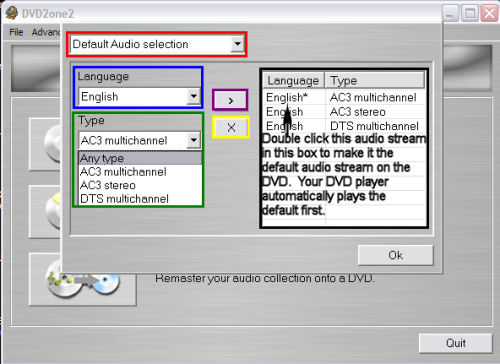
Next is the "Default Subtitle selection" (red).
Just select the language you want (blue) and then click the "Add" button (green). Just like in the audio selection, you can double click which subtitle stream to play by default if any.) (Screen Shot Below) 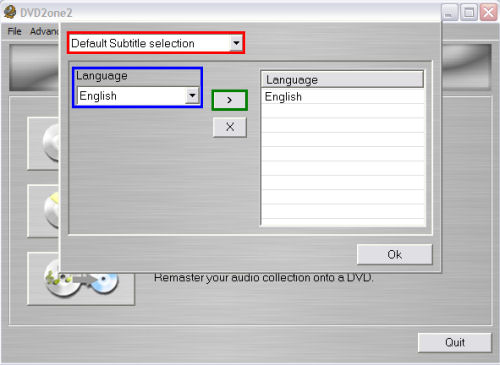 Next is the "Audio Remaster" selection" (red). You have two options to pick from. "Disabled" (blue) Artist and album names are not automatically filled in for an album. "From directory path of songs" (green) The artist and album names are extracted from the directory path of the filenames of the songs. This is possible because iTunes organizes its files in subdirectories per artist and subdirectories per album. Also on the PC you can instruct audio grabbers like CDeX and ExactAudioCopy to organize the music this way. DVD2One supports the following 2 formats (# is an optional song index): Artist/Album/# Song : This is the format iTunes uses, with 2 subdirectories. Artist - Album/# Song : This format has only 1 subdirectory. Example for the Mac: ~/Music/iTunes/iTunes Music/Madonna/Ray of Light/09 Frozen.m4a 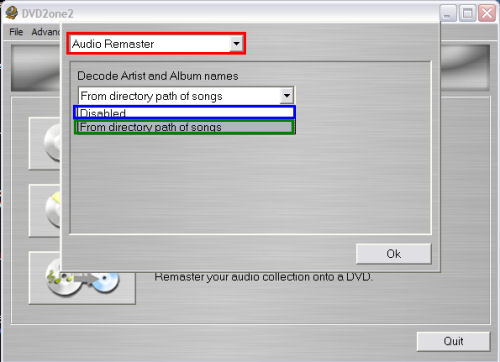
Next is the "Grid Master" section (red).
In this section of the preferences you can select which computers DVD2One can use as slaves in movie-only, join and full disk copy mode. Just enter the hostname of the slave computer (blue) and the TCP/IP port number to connect to (green), and click the > button (purple) to this computer to the list. You can remove entries with the x button (yellow). Grid Enabled When this option is enabled, DVD2One will connect through the network to all computers in the list (black). Hostname Here you have to fill in the name or IP address of the computer you want to add to the slave list. You can find the hostname and IP address of the slave on the 'Grid Slave' screen in the preferences on the slave computer (blue). Port number Here you have to fill in the TCP/IP port number on which the slave computer is 'listening'. This number has to match with the value that is filled in section 'Grid Slave' on the slave computer (green). 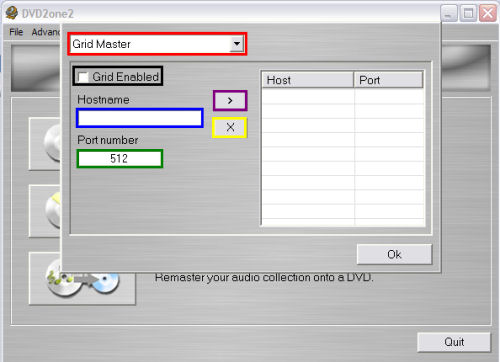 Last is the "Grid Slave" section (red). This screen shows, besides slave specific options, also the hostname and IP address of this computer. You can use this information to add this computer as slave to the master computer (black). Auto start in grid slave mode When this option is enabled, DVD2One will startup in slave mode when your computer boots (blue). Port Number This is the TCP/IP port number at which DVD2One will listen in slave mode. The master computer must connect to the same port number to be able to connect to this computer (green). 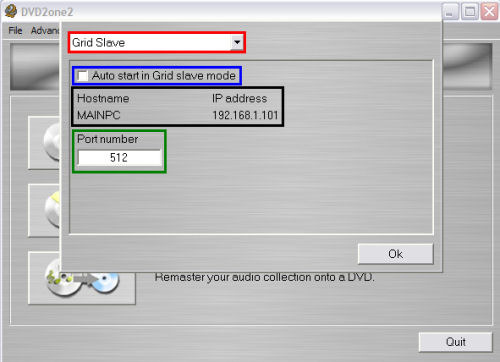
Now that your settings are correct, lets start backing up DVD's!
Start up DVD2One, then click the first button (red). After clicking the first button, the "Browse For Folder" window will come up (blue). Find your folder, click the little plus sign out beside it and click the "VIDEO_TS" folder (green). Then click the "OK" button (purple). (Screen Shot Below) 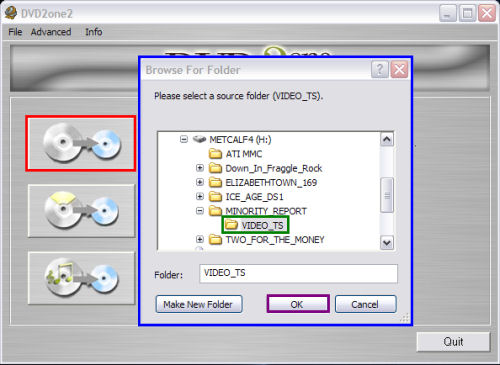 After clicking the "OK" button, you are brought to a review screen to make sure your settings are what you want (red). It gives information about your current settings that will be applied to this backup. For any reason you would like to change some of these settings, do it now (Go to next page to read on how to change your settings). Otherwise just click "Start processing" button (blue) to begin the process.
If you would like to change your settings, you will notice 3 words on the left hand side. They are "Settings", "Source", and "Audio". Click on each one to change specific settings for that category.
In Settings (purple) you can change the output size (If you are burning to SL disc's, DL disc's, or you can set your own custom size) (red), the compression Mode (Good quality or Fast) (blue), and at what level you want it (Automatic, Low, Medium, High) (green). (Screen Shot Below) 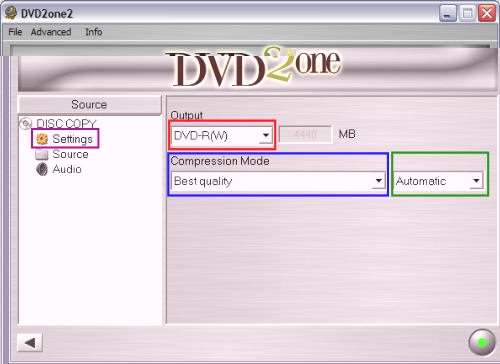 In Source (purple) you can set the input directory for DVD2One to use to create your backup by clicking the Select button (red), then choosing a VIDEO_TS folder (green) or the folder with your files in it on the "Browse For Folder" (blue) screen that pops up. (Screen Shot Below) 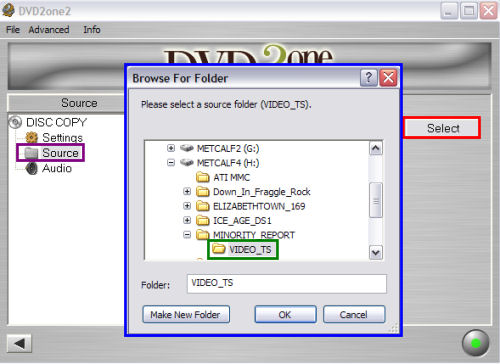
In Audio (purple) you can review and change the audio streams you selected. To add a stream, put a check mark in the box out beside the audio stream you want on the backup (red). To remove a stream, take the check mark out of the box (blue). (Screen Shot Below)
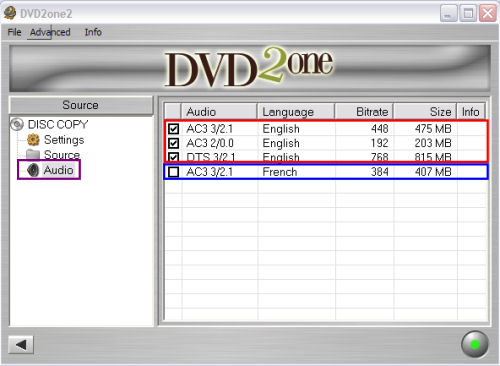 After you done making all of your changes, click the button with the green dot in the middle thats in the lower left hand corner of the DVD2One window to proceed. After clicking that button, the "Browse For Folder" window will pop up asking you to pick a destination folder (blue) (Depending on what Output Type you selected. In this guide I selected "File set".) Notice there are two MINORITY_REPORT folder, one on drive H: and one drive D: . Drive H: was my input directory (green) . Drive D: is my output directory (purple). (Screen Shot Below) 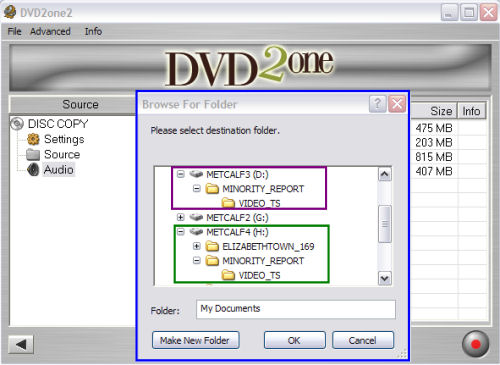
After clicking the "OK" button to select your destination directory, DVD2One will start the encoding process. A window will pop up displaying what percent its at (red), time elapsed so far (blue), time remaining (green), and total estimated time for the whole process to complete (purple). (Screen Shot Below)
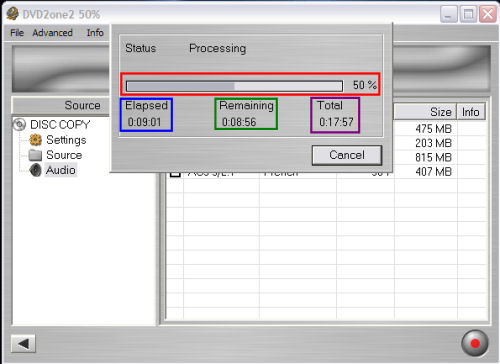 This screen will come up when its finished, just click the "OK" button (red). After clicking the "OK" button, it will just return you back to the main DVD2One screen. You may now exit DVD2One. You can burn the files it created with your favorite burning program or if you selected "Burn" as your output type, DVD2One would have also burned it for you. 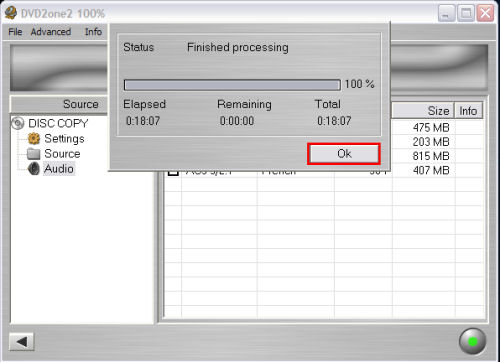 Enjoy your newly created DVD! |